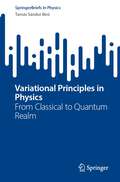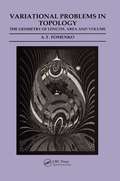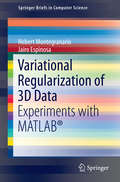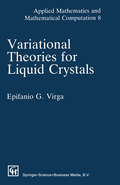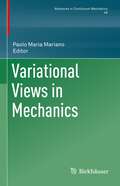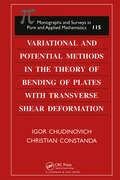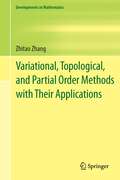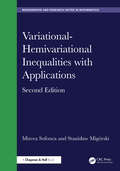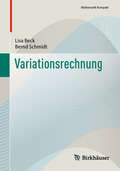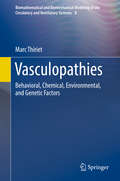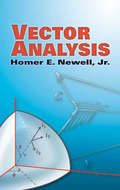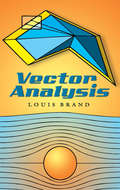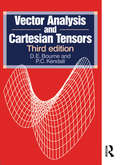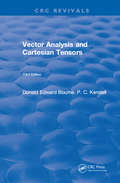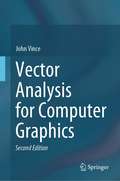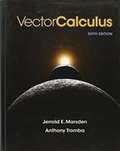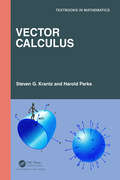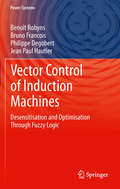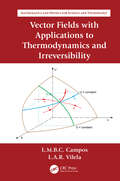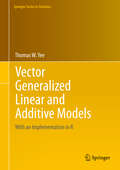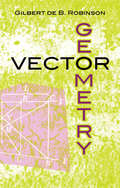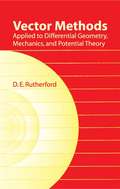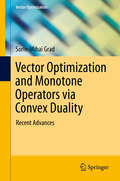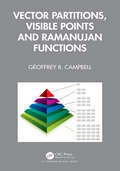- Table View
- List View
Variational Principles in Physics: From Classical to Quantum Realm (SpringerBriefs in Physics)
by Tamás Sándor BiróThis book is an English translation from a Hungarian book designed for graduate and postgraduate students about the use of variational principles in theoretical physics. Unlike many academic textbooks, it dashes across several lecture disciplines taught in physics courses. It emphasizes and demonstrates the use of the variational technique and philosophy behind the basic laws in mechanics, relativity theory, electromagnetism, and quantum mechanics. The book is meant for advanced students and young researchers in theoretical physics but, also, more experienced researchers can benefit from its reading.
Variational Problems in Topology: The Geometry of Length, Area and Volume
by A.T. FomenkoMany of the modern variational problems of topology arise in different but overlapping fields of scientific study: mechanics, physics and mathematics. In this work, Professor Fomenko offers a concise and clear explanation of some of these problems (both solved and unsolved), using current methods of analytical topology. His book falls into three interrelated sections. The first gives an elementary introduction to some of the most important concepts of topology used in modern physics and mechanics: homology and cohomology, and fibration. The second investigates the significant role of Morse theory in modern aspects of the topology of smooth manifolds, particularly those of three and four dimensions. The third discusses minimal surfaces and harmonic mappings, and presents a number of classic physical experiments that lie at the foundations of modern understanding of multidimensional variational calculus. The author's skilful exposition of these topics and his own graphic illustrations give an unusual motivation to the theory expounded, and his work is recommended reading for specialists and non-specialists alike, involved in the fields of physics and mathematics at both undergraduate and graduate levels.
Variational Regularization of 3D Data
by Hebert Montegranario Jairo EspinosaVariational Regularization of 3D Data provides an introduction to variational methods for data modelling and its application in computer vision. In this book, the authors identify interpolation as an inverse problem that can be solved by Tikhonov regularization. The proposed solutions are generalizations of one-dimensional splines, applicable to n-dimensional data and the central idea is that these splines can be obtained by regularization theory using a trade-off between the fidelity of the data and smoothness properties. As a foundation, the authors present a comprehensive guide to the necessary fundamentals of functional analysis and variational calculus, as well as splines. The implementation and numerical experiments are illustrated using MATLAB®. The book also includes the necessary theoretical background for approximation methods and some details of the computer implementation of the algorithms. A working knowledge of multivariable calculus and basic vector and matrix methods should serve as an adequate prerequisite.
Variational Theories for Liquid Crystals
by E.G. VirgaEssentially there are two variational theories of liquid crystals explained in this book. The theory put forward by Zocher, Oseen and Frank is classical, while that proposed by Ericksen is newer in its mathematical formulation although it has been postulated in the physical literature for the past two decades. The newer theory provides a better explanation of defects in liquid crystals, especially of those concentrated on lines and surfaces, which escape the scope of the classical theory. The book opens the way to the wealth of applications that will follow.
Variational Views in Mechanics (Advances in Mechanics and Mathematics #46)
by Paolo Maria MarianoThis volume provides a timely survey of interactions between the calculus of variations and theoretical and applied mechanics. Chapters have been significantly expanded since preliminary versions appeared in a special issue of the Journal of Optimization Theory and Applications (184(1), 2020) on “Calculus of Variations in Mechanics and Related Fields”. The variety of topics covered offers researchers an overview of problems in mechanics that can be analyzed with variational techniques, making this a valuable reference for researchers in the field. It also presents ideas for possible future areas of research, showing how the mastery of these foundational mathematical techniques can be used for many exciting applications. Specific topics covered include:Topology optimizationIdentification of material propertiesOptimal controlPlastic flowsGradient polyconvexityObstacle problemsQuasi-monotonicity Variational Views in Mechanics will appeal to researchers in mathematics, solid-states physics, and mechanical, civil, and materials engineering.
Variational and Potential Methods in the Theory of Bending of Plates with Transverse Shear Deformation (Monographs and Surveys in Pure and Applied Mathematics)
by I. Chudinovich Christian ConstandaElastic plates form a class of very important mechanical structures that appear in a wide range of practical applications, from building bodies to microchip production. As the sophistication of industrial designs has increased, so has the demand for greater accuracy in analysis. This in turn has led modelers away from Kirchoff's classical theory fo
Variational, Topological, and Partial Order Methods with Their Applications
by Zhitao ZhangNonlinear functional analysis is an important branch of contemporary mathematics. It's related to topology, ordinary differential equations, partial differential equations, groups, dynamical systems, differential geometry, measure theory, and more. In this book, the author presents some new and interesting results on fundamental methods in nonlinear functional analysis, namely variational, topological and partial order methods, which have been used extensively to solve existence of solutions for elliptic equations, wave equations, Schrödinger equations, Hamiltonian systems etc., and are also used to study the existence of multiple solutions and properties of solutions. This book is useful for researchers and graduate students in the field of nonlinear functional analysis.
Variational-Hemivariational Inequalities with Applications (Chapman & Hall/CRC Monographs and Research Notes in Mathematics)
by Mircea Sofonea Stanislaw MigorskiVariational-Hemivariational Inequalities with Applications, Second Edition represents the outcome of the cross-fertilization of nonlinear functional analysis and mathematical modelling, demonstrating its application to solid and contact mechanics. Based on authors’ original results, the book illustrates the use of various functional methods (including monotonicity, pseudomonotonicity, compactness, penalty and fixed-point methods) in the study of various nonlinear problems in analysis and mechanics. The classes of history-dependent operators and almost history-dependent operators are exposed in a large generality. A systematic and unified presentation contains a carefully selected collection of new results on variational-hemivariational inequalities with or without unilateral constraints. A wide spectrum of static, quasistatic, dynamic contact problems for elastic, viscoelastic and viscoplastic materials illustrates the applicability of these theoretical results.Written for mathematicians, applied mathematicians, engineers and scientists, this book is also a valuable tool for graduate students and researchers in nonlinear analysis, mathematical modelling, mechanics of solids, and contact mechanics.New to the second edition Convergence and well-posedness results for elliptic and history-dependent variational-hemivariational inequalities Existence results on various optimal control problems with applications in solid and contact mechanics Existence, uniqueness and stability results for evolutionary and differential variational-hemivariational inequalities with unilateral constraints Modelling and analysis of static and quasistatic contact problems for elastic and viscoelastic materials with looking effect Modelling and analysis of viscoelastic and viscoplastic dynamic contact problems with unilateral constraints.
Variationsrechnung (Mathematik Kompakt)
by Bernd Schmidt Lisa BeckDieses Lehrbuch bietet fortgeschrittenen Studierenden im Bachelorstudium eine konzise Einführung in das Gebiet der Variationsrechnung und eignet sich als Grundlage einer einsemestrigen Vorlesung. Es beginnt mit einigen klassischen Variationsproblemen und Ergebnissen zu Minimalflächen. Der Schwerpunkt liegt jedoch auf den modernen Aspekten der Variationsrechnung. Das Hauptaugenmerk gilt dabei den Variationsintegralen für "vektorwertige Probleme", für die Minimierer mit der "direkten Methode der Variationsrechnung" gesucht werden. Als adäquate Funktionenräume hierfür werden die "Sobolevräume" ausführlich behandelt. Auch die Relaxation solcher Funktionale wird eingehend diskutiert. Schließlich wird eine Einführung in die Theorie der Gamma-Konvergenz bis hin zu aktuellen Anwendungen auf Mehrskalenprobleme gegeben.
Vasculopathies: Behavioral, Chemical, Environmental, and Genetic Factors (Biomathematical and Biomechanical Modeling of the Circulatory and Ventilatory Systems #8)
by Marc ThirietThis volume presents one of the clinical foundations of vasculopathies: the biological markers and risk factors associated with cardiovascular disease. A detailed biological and clinical framework is provided as a prerequisite for adequate modeling. Chapter 1 presents cardiovascular risk factors and markers, where the search for new criteria is aimed at improving early detection of chronic diseases. The subsequent chapters focus on hypertension, which involves the kidney among other organs as well as many agents, hyperglycemia and diabetes, hyperlipidemias and obesity, and behavior. The last of these risk factors includes altered circadian rhythm, tobacco and alcohol consumption, physical inactivity, and diet. The volumes in this series present all of the data needed at various length scales for a multidisciplinary approach to modeling and simulation of flows in the cardiovascular and ventilatory systems, especially multiscale modeling and coupled simulations. The cardiovascular and respiratory systems are tightly coupled, as their primary function is to supply oxygen to and remove carbon dioxide from the body's cells. Because physiological conduits have deformable and reactive walls, macroscopic flow behavior and prediction must be coupled to nano- and microscopic events in a corrector scheme of regulated mechanisms. Therefore, investigation of flows of blood and air in anatomical conduits requires an understanding of the biology, chemistry, and physics of these systems together with the mathematical tools to describe their functioning in quantitative terms.
Vector Analysis (Dover Books on Mathematics)
by Homer E. Newell Jr.When employed with skill and understanding, vector analysis can be a practical and powerful tool. This text develops the algebra and calculus of vectors in a manner useful to physicists and engineers. Numerous exercises (with answers) not only provide practice in manipulation but also help establish students' physical and geometric intuition in regard to vectors and vector concepts.Part I, the basic portion of the text, consists of a thorough treatment of vector algebra and the vector calculus. Part II presents the illustrative matter, demonstrating applications to kinematics, mechanics, and electromagnetic theory. The text stresses geometrical and physical aspects, but it also casts the material in such a way that the logical structure of the subject is made plain. Serious students of mathematics can rigorize the treatment to their own satisfaction. Although intended primarily as a college text, this volume may be used as a reference in vector techniques or as a guide to self-education.
Vector Analysis (Dover Books on Mathematics)
by Louis BrandThe use of vectors not only simplifies treatments of differential geometry, mechanics, hydrodynamics, and electrodynamics, but also makes mathematical and physical concepts more tangible and easy to grasp. This text for undergraduates was designed as a short introductory course to give students the tools of vector algebra and calculus, as well as a brief glimpse into these subjects' manifold applications. The applications are developed to the extent that the uses of the potential function, both scalar and vector, are fully illustrated. Moreover, the basic postulates of vector analysis are brought to the foreground, placing their logical structure in sharp relief.Because the concept of a vector has been greatly generalized in geometry and mathematical physics, this text concludes with a brief introduction to abstract vector spaces, together with the ideas of linear dependence, basis, and dimension. The exposition of these abstract concepts is kept simple and clear. Numerous figures appear throughout the text.
Vector Analysis and Cartesian Tensors (Third Edition)
by P C KendallThis is a comprehensive and self-contained text suitable for use by undergraduate mathematics, science and engineering students. Vectors are introduced in terms of cartesian components, making the concepts of gradient, divergent and curl particularly simple. The text is supported by copious examples and progress can be checked by completing the many problems at the end of each section. Answers are provided at the back of the book.
Vector Analysis and Cartesian Tensors: Third Edition
by Donald Edward BourneThis is a comprehensive self-contained text suitable for use by undergraduate mathematics, science and engineering students following courses in vector analysis. The earlier editions have been used extensively in the design and teaching of may undergraduate courses. Vectors are introduced in terms of Cartesian components, an approach which is found to appeal to many students because of the basic algebraic rules of composition of vectors and the definitions of gradient divergence and curl are thus made particularly simple. The theory is complete, and intended to be as rigorous as possible at the level at which it is aimed.
Vector Analysis for Computer Graphics
by John VinceThis book is a complete introduction to vector analysis, especially within the context of computer graphics. The author shows why vectors are useful and how it is possible to develop analytical skills in manipulating vector algebra. Even though vector analysis is a relatively recent development in the history of mathematics, it has become a powerful and central tool in describing and solving a wide range of geometric problems. The book is divided into eleven chapters covering the mathematical foundations of vector algebra and its application to, among others, lines, planes, intersections, rotating vectors, and vector differentiation.
Vector Calculus
by Anthony Tromba Jerrold MarsdenVector Calculus helps students gain an intuitive and solid understanding of this important subject. The book's careful account is a contemporary balance between theory, application, and historical development, providing it's readers with an insight into how mathematics progresses and is in turn influenced by the natural world.
Vector Calculus
by Miroslav LovricThis book gives a comprehensive and thorough introduction to ideas and major results of the theory of functions of several variables and of modern vector calculus in two and three dimensions. Clear and easy-to-follow writing style, carefully crafted examples, wide spectrum of applications and numerous illustrations, diagrams, and graphs invite students to use the textbook actively, helping them to both enforce their understanding of the material and to brush up on necessary technical and computational skills. Particular attention has been given to the material that some students find challenging, such as the chain rule, Implicit Function Theorem, parametrizations, or the Change of Variables Theorem.
Vector Calculus (Textbooks in Mathematics)
by Harold Parks Steven G. KrantzUsing meaningful examples, credible applications, and incisive technology, Vector Calculus strives to empower students, enhance their critical thinking skills, and equip them with the knowledge and skills to succeed in the major or discipline they ultimately choose to study. This text is intended to be a cornerstone of that process. An engaging style and clear writing make the language of mathematics accessible, understandable, and enjoyable, with a high standard for mathematical rigor.A calculus book must tell the truth. This book is carefully written in the accepted language of mathematics in a readable exposition. It includes useful and fascinating applications, acquaints students with the history of the subject, and offers a sense of what mathematics is all about.Technique is presented, yet so are ideas. The authors help students to master basic methods and discover and build their own concepts in a scientific subject. There is an emphasis on using modeling and numerical calculation. Additional features include: A Quick Quiz and Problems for Practice, Further Theory and Practice, and Calculator/Computer Exercises appear at the end of each section All exercise sets are step laddered A Look Back and A Look Forward help students put the ideas in context Every chapter ends with a Genesis and Development section, giving history and perspective on key topics in the evolution of calculus Boxed Insights clear up points or answer commonly asked questions The text has an extra-large offering of examples Examples are illustrated with meaningful and useful graphics The pedagogical features make the subject more interesting and accessible to students than other texts, while maintaining an appropriate rigor. —Daniel Cunningham, CSU-FresnoThis text is truly well written and organized. I do like the fact the book is quite rigorous, yet full of illustrative examples. —Bob Devaney, Boston University
Vector Control of Induction Machines
by Bruno Francois Philippe Degobert Benoît Robyns Jean Paul HautierAfter a brief introduction to the main law of physics and fundamental concepts inherent in electromechanical conversion, Vector Control of Induction Machines introduces the standard mathematical models for induction machines - whichever rotor technology is used - as well as several squirrel-cage induction machine vector-control strategies. The use of causal ordering graphs allows systematization of the design stage, as well as standardization of the structure of control devices. Vector Control of Induction Machines suggests a unique approach aimed at reducing parameter sensitivity for vector controls based on a theoretical analysis of this sensitivity. This analysis naturally leads to the introduction of control strategies that are based on the combination of different controls with different robustness properties, through the use of fuzzy logic supervisors. Numerous applications and experiments confirm the validity of this simple solution, which is both reproducible and applicable to other complex systems. Vector Control of Induction Machines is written for researchers and postgraduate students in electrical engineering and motor drive design.
Vector Fields with Applications to Thermodynamics and Irreversibility (Mathematics and Physics for Science and Technology #10)
by Luis Manuel Braga da Costa Campos Luís António Raio VilelaVector Fields with Applications to Thermodynamics and Irreversibility is part of the series "Mathematics and Physics for Science and Technology", which combines rigorous mathematics with general physical principles to model practical engineering systems with a detailed derivation and interpretation of results. Volume V presents the mathematical theory of partial differential equations and methods of solution satisfying initial and boundary conditions, and includes applications to: acoustic, elastic, water, electromagnetic and other waves; the diffusion of heat, mass and electricity; and their interactions. This is the first book of the volume. The second book of volume V continues this book on thermodynamics, focusing on the equation of state and energy transfer processes including adiabatic, isothermal, isobaric and isochoric. These are applied to thermodynamic cycles, like the Carnot, Atkinson, Stirling and Barber-Brayton cycles, that are used in thermal devices, including refrigerators, heat pumps, and piston, jet and rocket engines. In connection with jet propulsion, adiabatic flows and normal and oblique shock waves in free space and nozzles with variable cross-section are considered. The equations of fluid mechanics are derived for compressible two-phase flow in the presence of shear and bulk viscosity, thermal conduction and mass diffusion. The thermodynamic cycles are illustrated by detailed calculations modelling the operation of piston, turbojet and rocket engines in various ambient conditions, ranging from sea level, the atmosphere of the earth at altitude and vacuum of space, for the propulsion of land, sea, air and space vehicles. The book is intended for graduate students and engineers working with mathematical models and can be applied to problems in mechanical, aerospace, electrical and other branches of engineering dealing with advanced technology, and also in the physical sciences and applied mathematics. This book: Simultaneously covers rigorous mathematics, general physical principles and engineering applications with practical interest Provides interpretation of results with the help of illustrations Includes detailed proofs of all results L.M.B.C. Campos was chair professor and the Coordinator of the Scientific Area of Applied and Aerospace Mechanics in the Department of Mechanical Engineering and also the director (and founder) of the Center for Aeronautical and Space Science and Technology until retirement in 2020. L.A.R.Vilela is currently completing an Integrated Master's degree in Aerospace Engineering at Institute Superior Tecnico (1ST) of Lisbon University.
Vector Generalized Linear and Additive Models
by Thomas W. YeeThis book presents a greatly enlarged statistical framework compared to generalized linear models (GLMs) with which to approach regression modelling. Comprising of about half-a-dozen major classes of statistical models, and fortified with necessary infrastructure to make the models more fully operable, the framework allows analyses based on many semi-traditional applied statistics models to be performed as a coherent whole. Since their advent in 1972, GLMs have unified important distributions under a single umbrella with enormous implications. However, GLMs are not flexible enough to cope with the demands of practical data analysis. And data-driven GLMs, in the form of generalized additive models (GAMs), are also largely confined to the exponential family. The methodology here and accompanying software (the extensive VGAM R package) are directed at these limitations and are described comprehensively for the first time in one volume. This book treats distributions and classical models as generalized regression models, and the result is a much broader application base for GLMs and GAMs. The book can be used in senior undergraduate or first-year postgraduate courses on GLMs or categorical data analysis and as a methodology resource for VGAM users. In the second part of the book, the R package VGAM allows readers to grasp immediately applications of the methodology. R code is integrated in the text, and datasets are used throughout. Potential applications include ecology, finance, biostatistics, and social sciences. The methodological contribution of this book stands alone and does not require use of the VGAM package.
Vector Geometry
by Gilbert De RobinsonThis brief undergraduate-level text by a prominent Cambridge-educated mathematician explores the relationship between algebra and geometry. An elementary course in plane geometry is the sole requirement for Gilbert de B. Robinson's text, which is the result of several years of teaching and learning the most effective methods from discussions with students. Topics include lines and planes, determinants and linear equations, matrices, groups and linear transformations, and vectors and vector spaces. Additional subjects range from conics and quadrics to homogeneous coordinates and projective geometry, geometry on the sphere, and reduction of real matrices to diagonal form. Exercises appear throughout the text, with complete answers at the end.
Vector Methods: Applied to Differential Geometry, Mechanics, and Potential Theory
by D. E. RutherfordDesigned to familiarize undergraduates with the methods of vector algebra and vector calculus, this text offers both a clear view of the abstract theory as well as a concise survey of the theory's applications to various branches of pure and applied mathematics. A chapter on differential geometry introduces readers to the study of this subject by the methods of vector algebra. The next section explores the many aspects of the theory of mechanics adaptable to the use of vectors, and a full discussion of the vector operator "nabla" proceeds to a treatment of potential theory and Laplace's equation. This includes applications to the theories of gravitation, hydrodynamics, and electricity. A brief chapter on four-dimensional vectors concludes the text.
Vector Optimization and Monotone Operators via Convex Duality
by Sorin-Mihai GradThis book investigates several duality approaches for vector optimization problems, while also comparing them. Special attention is paid to duality for linear vector optimization problems, for which a vector dual that avoids the shortcomings of the classical ones is proposed. Moreover, the book addresses different efficiency concepts for vector optimization problems. Among the problems that appear when the framework is generalized by considering set-valued functions, an increasing interest is generated by those involving monotone operators, especially now that new methods for approaching them by means of convex analysis have been developed. Following this path, the book provides several results on different properties of sums of monotone operators.
Vector Partitions, Visible Points and Ramanujan Functions
by Geoffrey B. CampbellVector Partitions, Visible Points and Ramanujan Functions offers a novel theory of Vector Partitions, though very much grounded in the long-established work of others, that could be developed as an extension to the existing theory of Integer Partitions. The book is suitable for graduate students in physics, applied mathematics, number theory and computational mathematics. It takes the reader up to research level, presenting new results alongside known classical results from integer partitions and areas of vector and multipartite partition theory. It also sets forth new directions for research for the more advanced reader.Above all, the intention of the book is to bring new inspiration to others who study mathematics and related areas. It is hoped that some new ideas will be launched to add value and insight into many of the classical and new theories surrounding partitions. The book is an appreciation of the many gifted authors of research into partitions over the past century and before, in the hope that more may come of this for future generations.Features Provides a step-by-step guide through the known literature on Integer and Vector Partitions, and a focus on the not so well-known Visible Point Vector identities Serves as a reference for graduate students and researchers in physics, applied mathematics, number theory and computational mathematics Offers a variety of practical examples as well as sets of exercises suitable for students and researchers Geoffrey B. Campbell completed his PhD at Australian National University in 1998 under the esteemed physicist Professor Rodney Baxter. His affiliation with the Australian National University Mathematical Sciences Institute has continued for over 30 years. Within that time frame, Geoffrey also served eight years as an Honorary Research Fellow at LaTrobe University Mathematics and Statistics Department in Melbourne. Currently he writes ongoing articles for the Australian Mathematical Society Gazette. Within the international scope, Geoffrey currently serves as a PhD external committee member for a mathematics graduate student at Washington State University in America.Geoffrey has built a career within Australian Commonwealth and State government departments, including as an Advisor at the Department of Prime Minister and Cabinet; as Analyst Researcher for a Royal Commission. Geoffrey specializes in complex data, machine learning including data analytics. He is also a published poet in Australian anthologies and literary magazines.
